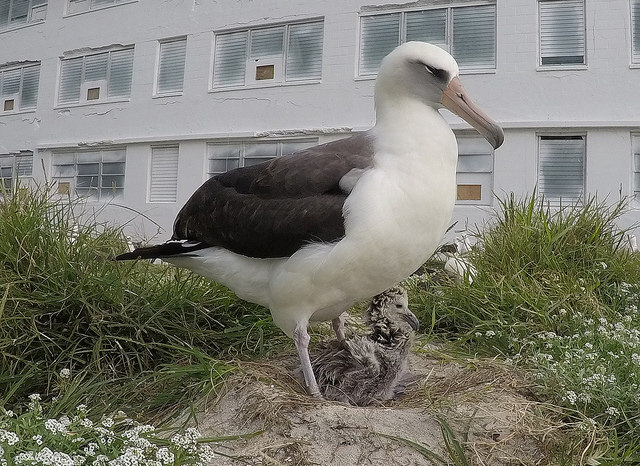67-Year-Old Seabird Hatches Chick at Midway Atoll
 At 67, Wisdom, the world’s oldest known breeding bird in the wild, became a mother once again.
At 67, Wisdom, the world’s oldest known breeding bird in the wild, became a mother once again.
On Feb, 6, 2018, approximately two months after Wisdom began incubating her egg, Wisdom and her mate, Akeakami, welcomed their newest chick to Midway Atoll.
Midway Atoll National Wildlife Refuge and Battle of Midway National Memorial within Papahānaumokuākea Marine National Monument is a special place for over three million seabirds—they return to Midway Atoll each year to rest, mate, lay eggs and raise their chicks.
“Laysan albatross and other seabirds depend on the habitat protected by Midway Atoll and other remote Pacific wildlife refuges,” said Bob Peyton, U.S. Fish and Wildlife Service Refuge manager for Midway Atoll Refuge and Memorial.
Albatrosses and other seabirds return to the same nesting site each year. A single egg is laid and incubated for a little over two months. After the chick hatches, it will still be another five months before it will leave the nest. In that time, Wisdom and Akeakamai, like all albatross parents, take turns incubating the egg or caring for the chick while the other forages for food at sea.
“Midway Atoll’s habitat doesn’t just contain millions of birds, it contains countless generations and families of albatrosses,” said Kelly Goodale, U.S. Fish and Wildlife Service Refuge biologist. “If you can imagine when Wisdom returns home she is likely surrounded by what were once her chicks and potentially their chicks. What a family reunion!”
Wisdom has successfully raised at least 30 to 36 albatross chicks over the course of her life. Because Laysan albatross don’t lay eggs every year and raise only one chick at a time when they do, the contribution of one bird to the population makes a huge difference. Wisdom’s recent addition has expanded her albatross family and contributes to the continued health of the Laysan albatross population overall.
The refuge is home to the largest albatross colony in the world and is the most important and successful breeding colony for black-footed albatross (Phoebastria nigripes) and Laysan albatross (Phoebastria immutabilis). Globally significant as a critical nesting habitat for seabirds, Midway is home to 36 percent of all black-footed albatross and 73 percent of all Laysan albatross, as well as the endangered short-tailed albatross (Phoebastria albatrus). Albatross start to arrive from sea to breed in late October and by the end of November nearly every available nesting space on Midway Atoll is claimed by a breeding pair.
“Albatross invest an enormous amount of resources to raise their chicks” said Peyton. “Albatrosses and other seabirds choose Midway as their home because it’s a safe place. Thanks to the hard work of staff and volunteers, we are restoring the native habitat that the birds need for nesting sites, ensuring a future for these seabirds.”
Located at the far northern end of the Hawaiian archipelago within Papahānaumokuākea Marine National Monument, Midway Atoll National Wildlife Refuge and Battle of Midway National Memorial is managed by the U.S. Fish and Wildlife Service. One the oldest atoll formations in the world, Midway provides nesting habitat for over three million seabirds, and was the site of the decisive World War II Battle of Midway, one of the most significant naval battles in history. To learn more about Midway Atoll, go online.
Papahānaumokuākea is cooperatively managed to ensure ecological integrity and achieve strong, long-term protection and perpetuation of Northwestern Hawaiian Island ecosystems, Native Hawaiian culture, and heritage resources for current and future generations. Four co-trustees—the Department of Commerce, Department of the Interior, State of Hawai‘i and the Office of Hawaiian Affairs—protect this special place. Papahānaumokuākea Marine National Monument was inscribed as the first mixed (natural and cultural) UNESCO World Heritage Site in the United States in July 2010. For more information, visit www.papahanaumokuakea.gov.














